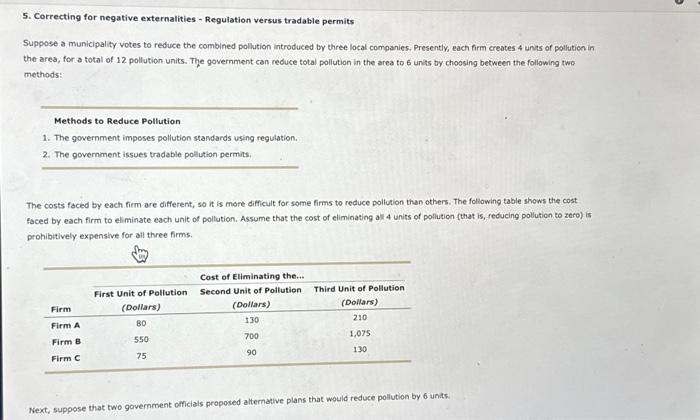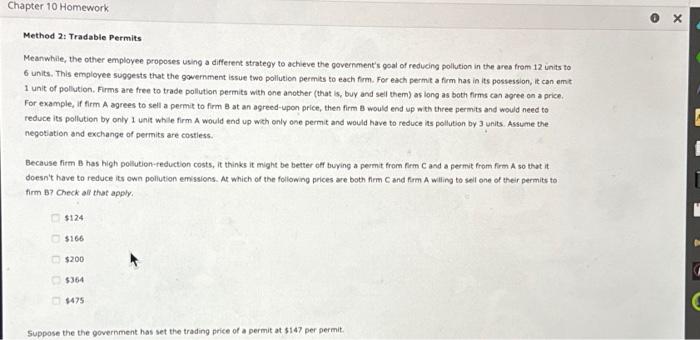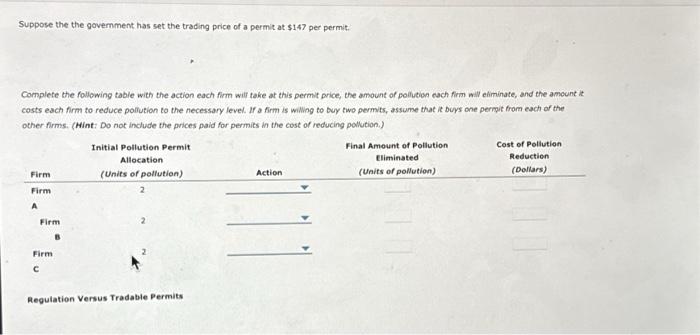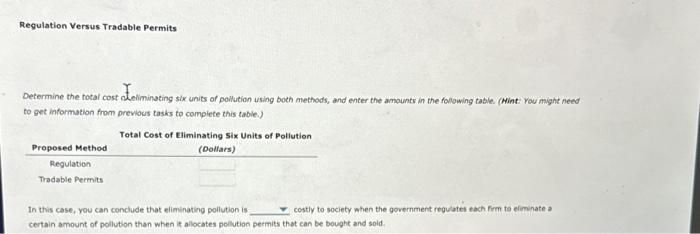5. Correcting for negative externalities - Regulation versus tradable permits Suppose a municipality votes to reduce the combined pollution introduced by three local companies. Presently, each firm creates 4 units of pollution in the area, for a total of 12 pollution units. The government can reduce total pollution in the area to 6 units by choosing between the following two methods: Methods to Reduce Pollution 1. The government imposes pollution standards using regulation. 2. The government issues tradabie polution permits. The costs faced by each firm are different, so it is more difficult for some firms to reduce pollution than others. The following table shows the cost faced by each firm to eliminate each unit of pollution. Assume that the cost of eliminating all 4 units of pollution (that is, reducing pollution to aero) is prohibitively expensive for all three firms. Next, suppose that two government officials proposed altemative plans that would reduce pollution by 6 units. The first govemment employee suggests reducing pollution through regulation. To meet the pollution goal, the government requires each firm to reduce its pollution by 2 units. Complete the following tabie with the total cost to each firm of reducing its poilution or 2 units. Method 2: Tradable Permits Meanwhile, the other employee proposes using a different strategy to achieve the government's goal of reducing pollution in the ares from 12 inits to 6 units. This emplovee suggests that the government issue two pollution permits to each firm. For each permit a firm has in its possession, it can emt 1 unit of pollution. Firms are free to trade pollution permits with one another (that is, buy and sell them) as long as both firms can apree on a price. For example, if firm A agrees to sell a permit to firm B at an agreed-upon price, then firm B would end up with three permits and would need to reduce its pollution by only 1 unit while firm A would end up wich enly one permit and would have to reduce its pollution by 3 units. Assume the negotiation and exchange of permits are costiess. Because firm B has high pollution-reduction costs, it thinks it might be better off buying a permit from frm C and a permit from fren A so that it doesn't have to reduce its own poliution emissions. At which of the following prices are both firm Cand firm A willing to seil one of their permits to firm B? Check all that apply. $124 5166 $200 $364 4475 Suppose the the government has set the trading price of a permit at $147 per permit. Suppose the the govemment has set the trading price of a permit at $147 per permit. Complete the following table with the action each firm wilf take at this permit price, the amount of pollucion cach firm will eiminate, and the amount it costs each firm to reduce poinution to the necessary level. If a firm is wingg to buy two permits, assume that it buys one permit trom each of the other firms. (Hint: Do not include the prices paid for permits in the cost of reducing pollution.) Aegulation Versus Tradable Permits Regulation Versus Tradable Permits Determine the total cost deliminating six units of pollution using both methods, and enter the amounts in the following table (Hint: You might neted to get information from previous tasks to complete this table.) In this case, you can conclude that eliminating pollution is costly to society when the government regulates ebch firm to eliminate a certain amount of poliution than when if allocates pollution permits that can be bought and sold











